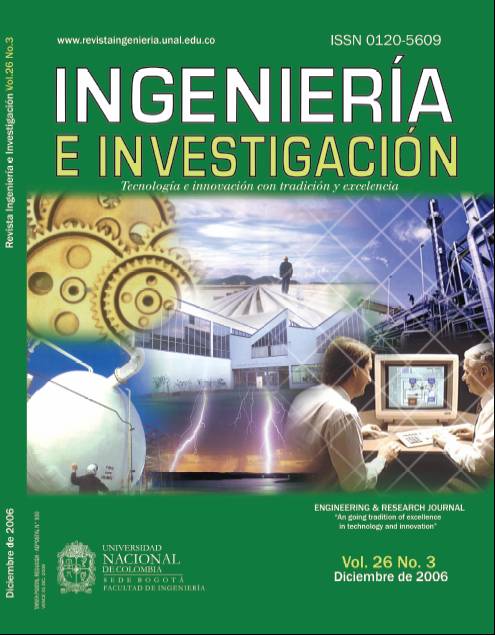Using ANFIS networks and current signals for locating faults in power distribution systems
Utilización de redes ANFIS y señales de corriente para localización de la zona de falla en sistemas de distribución de energía eléctrica
DOI:
https://doi.org/10.15446/ing.investig.v26n3.14757Keywords:
power quality, fault location, signal characterisation, ANFIS networks (en)calidad de potencia, localización de fallas, caracterización de señales, redes ANFIS (es)
Downloads
Fault location in power distribution systems is very important because of power service continuity requirements, mainly imposed by current electricity market quality standards. A fault location approach is adopted in this paper using current waveforms as measured at electricity substations, knowledge of protection-device settings and ANFIS networks. Good results were obtained from tests carried out in a prototype power distribution system to locate where faults were occurring. These results revealed variation in fault-locator precision due to using different current signal characteristics or descriptors. An error lower than 1% was obtained in the best case. Two more alternatives are also presented where errors were lower than 4%; such results validate the approach presented here.
El problema de la localización de fallas en sistemas de distribución de energía eléctrica es muy importante debido a los requerimientos de continuidad del servicio, impuestos por las normativas de calidad propias del mercado eléctrico actual. En este artículo se presenta una alternativa de localización de fallas que sólo utiliza las señales de corriente medidas en la subestación de distribución, el conocimiento de la calibración del sistema de protecciones y redes neurodifusas ANFIS. A partir de las pruebas realizadas en un sistema de distribución prototipo, se obtienen buenos resultados para la localización de la zona donde se originó la falla. Estos resultados muestran la variación de la precisión del localizador ante el uso de diferentes características o descriptores de las señales de corriente. En el mejor de los casos, el error encontrado es inferior al 1%; pero también se presentan dos alternativas adicionales para las cuales el error es inferior al 4%, lo cual valida plenamente la propuesta aquí presentada.
References
Bollen, M., Understanding Power Quality Problems: Voltage Sags and Interruptions., IEEE Press., 2000. DOI: https://doi.org/10.1109/9780470546840
Choi, M., Lee, S., Lee, D. and Jin, B., A new fault location algorithm using direct circuit analysis for distribution systems., IEEE Transactions on Power Systems, 2004, pp. 35-41. DOI: https://doi.org/10.1109/TPWRD.2003.820433
Dagenhart, J. B., The 40- Ground-Fault Phenomenon., IEEE Transactions on Industry Applications, Vol. 36, No. 1, 2000, pp. 30-32. DOI: https://doi.org/10.1109/28.821792
Das, R., Determining the locations of faults in distribution systems., Tesis para optar por el título de doctor, University of Saskatchewan Saskatoon, Canada, 1998, pp. 206.
García, V., Aplicación de la DWT en la detección e identificación de eventos de calidad de energía eléctrica., Tesis para optar por el título de ingeniero electricista, Universidad Industrial de Santander, Colombia, 2004.
Lee, S., Choi, M., Kang, S., Jin, B., Lee, B. and Ahn, B., An intelligent and Efficient Fault Location and Diagnosis Scheme for Radial Distribution Systems., IEEE Transactions on Power Delivery, Vol. 19, No. 2, 2004, pp. 524-531. DOI: https://doi.org/10.1109/TPWRD.2003.820431
Leuven EMTP Center - LEC., Alternative Transient Program., ATP. Rule Book, 1998.
Mora, J. y Meléndez, J., Caracterización de huecos de tensión para localización de fallas en sistemas de distribución - un primer paso hacia un método hibrido., Revista Scientia et Técnica, ISSN 0122-1701, No 25, 2004, pp. 45-52.
Mora, J., Muñoz, S., y Carrillo, G., Técnicas algorítmicas de localización de faltas como alternativa para reducir el efecto de las salidas en sistemas de potencia - Una revisión., III Internacional Simposium of Power Quality, Colombia, Bogotá, CD proceedings, 2005.
Mora, J., Melendez, J. and Bedoya, J., Extensive Events Database Development using ATP and Matlab to Fault Location in Power Distribution Systems., In proceedings of 2006 IEEE PES, Transmission and Distribution Conference and Exposition, August, Caracas, 2006. DOI: https://doi.org/10.1109/TDCLA.2006.311426
Novosel, D., Hart, D. and Myllymaki, J., System for locating faults and estimating fault resistance in distribution networks with tapped loads., US Patent number 5,839,093, 1998.
Phadke, A. and Horowitz S., Power System Relaying., Research studies press, Baldock, England, 1995.
Russell, S. and Norwing, P, Artificial Intelligence: A Modern Approach., Second Edition., Prentice Hall, 2002.
Takagi, T., Yamakoshi, Y., Baba, J., Uemura, K. and Sakaguchi, T., A new algorithm of an accurate fault location for EHV/UHV transmission lines: Part-Fourier transform method., IEEE Transactions Power App. Syst., Vol. PAS-100, Mar, 1981, pp. 1316-1323. DOI: https://doi.org/10.1109/TPAS.1981.316604
How to Cite
APA
ACM
ACS
ABNT
Chicago
Harvard
IEEE
MLA
Turabian
Vancouver
Download Citation
License
Copyright (c) 2006 Juan José Mora Flórez, Lucas Paul Pérez Hernández, Sandra Milena Pérez Londoño

This work is licensed under a Creative Commons Attribution 4.0 International License.
The authors or holders of the copyright for each article hereby confer exclusive, limited and free authorization on the Universidad Nacional de Colombia's journal Ingeniería e Investigación concerning the aforementioned article which, once it has been evaluated and approved, will be submitted for publication, in line with the following items:
1. The version which has been corrected according to the evaluators' suggestions will be remitted and it will be made clear whether the aforementioned article is an unedited document regarding which the rights to be authorized are held and total responsibility will be assumed by the authors for the content of the work being submitted to Ingeniería e Investigación, the Universidad Nacional de Colombia and third-parties;
2. The authorization conferred on the journal will come into force from the date on which it is included in the respective volume and issue of Ingeniería e Investigación in the Open Journal Systems and on the journal's main page (https://revistas.unal.edu.co/index.php/ingeinv), as well as in different databases and indices in which the publication is indexed;
3. The authors authorize the Universidad Nacional de Colombia's journal Ingeniería e Investigación to publish the document in whatever required format (printed, digital, electronic or whatsoever known or yet to be discovered form) and authorize Ingeniería e Investigación to include the work in any indices and/or search engines deemed necessary for promoting its diffusion;
4. The authors accept that such authorization is given free of charge and they, therefore, waive any right to receive remuneration from the publication, distribution, public communication and any use whatsoever referred to in the terms of this authorization.



























